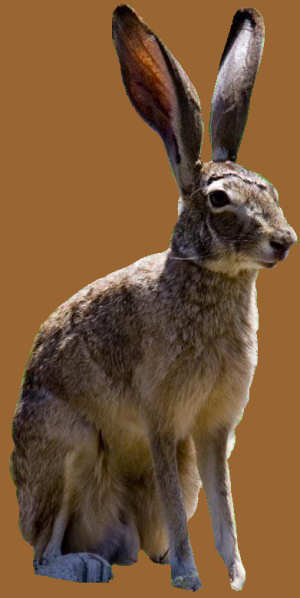|
The jack rabbit is a hare, ie, a lagomorph of
the running type (hares) rather than the burrowing type (rabbits).
Unfortunately, lagomorphs can be agricultural pests and in our
neighborhood, young grape vines have to be protected from them. His
huge ears provide good early warning protection from
some predators and a very important heat-radiating mechanism in our hot
summers.
The Black-tailed Jack Rabbit is 18
to
25 inches long and is colored buff peppered with black above, and white
below. The tail has a black stripe above. The ears are long and brown
with black tips. The Antelope Jack is approximately the same size, but
colored gray above with the lower sides mostly white. The face, throat
and ears are brownish, but there is no black tip on the ears.
Life Cycle
The Black-tailed Jack is by far the most common and is found
all over
the south west mountainous areas at elevations above 12,000
feet. (Kingman is at 1100 ft. while just east is the highest mountain
at 8400 ft.) They adapt themselves readily to man's use of the land and
thrive
even in highly developed areas.
In the more temperate areas of the Black-tailed Jack's range, breeding
may continue the year around. Usually several litters are born each
year. Here again there may be as many as 8, but the average litter is
from 2 to 4. The mother hides her young when she goes out to feed, and,
upon returning, mother and young call to locate each other.
They grow rather rapidly and reach
adult size in about 7 or 8 months. Sexual maturity is attained at about
the same time, but young females do not breed until early in the year
following their birth. Usually, the expectant mother provides no nest
for her young.
Hares have many natural enemies. Coyotes,
Bobcats, foxes, Horned Owls, hawks and snakes prey on both the young
and adults. At higher elevations the Marten and Fisher also prey on the
Snowshoe.
Hares are active primarily at night. During the
day they lie crouched
in a "form" which they have made by using the same spot in a clump of
grass or weeds. With their long ears flattened against their back, they
are difficult to see. Frequently on hot summer days, they can be seen
resting in the shade of a small bush or even a fence post. When
frightened they run with such speed that few dogs can catch them. At
the start of the chase their speed is broken by high long leaps.
Hares are strict vegetarians, eating a great
variety of herbs and
shrubs. In farming
areas the Black-tailed Jack may become a serious pest in young orchards
and to other agricultural crops.
It is estimated that nearly 2 million "Jack
Rabbits" are taken by
hunters annually in just California. The flesh is excellent eating. In
periods of high population, some Black-tailed Jacks, like other game
and non-game species, may become diseased and carry tularemia
or be a host to common animal parasites. While this is of minor
consequence to humans, care should be used in handling or skinning all
animals,
as some diseases are transmissible through open cuts or abrasions.
Cooking thoroughly eliminates any danger.
|

